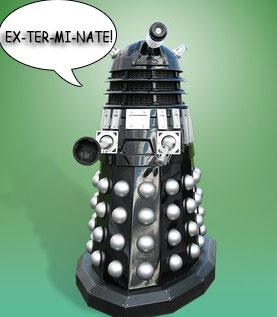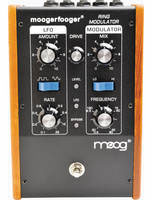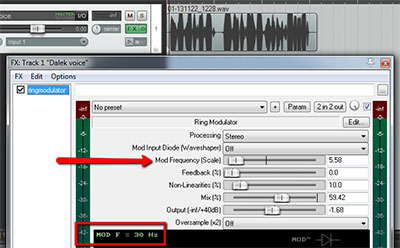 [This was originally posted during the week of Dr. Who celebrations around the 50th anniversary in 2013]. History celebrated the 50th anniversary of Doctor Who, and BBC America filled the week with all kinds of specials, premieres, a biopic, and marathons, to culminate in The Day of The Doctor special (the geek in me was all “a-squee” this week:)).
[This was originally posted during the week of Dr. Who celebrations around the 50th anniversary in 2013]. History celebrated the 50th anniversary of Doctor Who, and BBC America filled the week with all kinds of specials, premieres, a biopic, and marathons, to culminate in The Day of The Doctor special (the geek in me was all “a-squee” this week:)).
So what does this have to do with audio? Well if you’re a fan of Doctor Who, you’re probably aware of its most famous villain – the Daleks. These biological alien mutants living inside a tank-like mechanical shell. And they have a very distinctive voice, usually shouting “exterminate! exterminate!” Yeah, they have anger issues. But I digress. What about the audio? It’s that Dalek voice. How do they make it sound like that?
The actor who does the voice of the Daleks (they all sound pretty much the same) – currently Nicholas Briggs – speaks into a microphone hooked up to something called a “ring modulator.” Specifically, he uses a Moog Moogerfooger MF-102 Ring Modulator. They don’t simply process a voice-actor’s audio after-the-fact. Nicholas Briggs is actually on the set and in rehearsals with his audio rig so the other actors can actually hear the real Dalek voice while filming scenes. But what is a ring modulator?
Ring Modulator
A ring modulator is basically a box that mangles audio. Of course, there are plenty of ring modulator software programs – usually in the form of plugins for recording software – that can provide the same effect. If you really want to get into the reasons why it is called a “ring modulator,” and you geek out when you hear the terms “diode circuit” or “bridge rectifier,” you can read all about that here.
But the basics beyond “box that mangles audio” can be explained fairly clearly – in keeping with our mission to present needlessly or overly complex material so anyone can get it. A ring modulator combines two sounds in order to create that mangled audio I mentioned. So let’s start with a single sound, one audio signal. It could be anything – a voice, a drum, a pure tone sine wave, etc.
For the sake of keeping the explanation simple, lets say our sound (the first of the two) is a pure sine wave at a frequency of 440 Hz. That would be an A note, musically – that’s where the term “A440” comes from. If you “modulate” the frequency (which just means to change the frequency) to 880 Hz, you’d get an A note that is the next octave up (if you double the frequency of a note, you get that same note an octave higher). This effect doesn’t simply change octaves like that – there are a more complex things happening with the frequencies. But it’s sort of based on the same idea.
So a ring modulator combines the frequencies of two audio signals together and plays the result. But it also subtracts one frequency from the other. Then it outputs the blended result of both. Wacky, right?
In case you want a bit more information about all he stuff under the hood of ring modulation, check out the wikipedia article here: https://en.wikipedia.org/wiki/Ring_modulation.
The point is that ring modulation is the effect used to create the Dalek voice. Of course you can turn the knobs to change all sorts of parameters on the effect controls, like the frequencies and shape of the audio wave form for extra gnarly sound. But what you probably just want to know is how to make yourself sound like a Dalek, don’t you? Admit it. Yes you do.
How To Make Yourself Sound Like a Dalek

You COULD do it like Nicholas Briggs, and walk around talking into a microphone and carrying your Moogerfooger, microphone, and speaker with you. It would be fun to walk into a restaurant and order your food like a Dalek. Tell them to bring it quickly or they will be exterminated;). But though hilarious, that could be difficult and a bit pricey. The Moogerfooger goes for $289.
Here is how you do it much more affordably (or free, if you already have Reaper recording software).
Open a track in Reaper. Then click the “FX” button on the track control panel and find the effect called: “JS: Liteon/ringmodulator.” It comes with Reaper!
 Next, you will want to make one adjustment to the ring modulator. The first slider is called Mod Frequency (scale). Slide that to the left until it’s at about 5.58. See picture on the left. What you’re going for here is a modulation frequency of 30 Hz. The slider changes that number, which you can see in the black box at the bottom of the plugin (again, see the pic on the left).
Next, you will want to make one adjustment to the ring modulator. The first slider is called Mod Frequency (scale). Slide that to the left until it’s at about 5.58. See picture on the left. What you’re going for here is a modulation frequency of 30 Hz. The slider changes that number, which you can see in the black box at the bottom of the plugin (again, see the pic on the left).
Once that’s all set, you can close the FX window and record your voice.
Normally, I would STRONGLY advise against clipping your audio – which is what happens when your voice is too loud for the interface. You get distorted audio. But in this case, that’s what we want! In the picture, you can see (above the plugin window) my voice is all squared off on the top and bottom. That means it’s been clipped. So turn up your interface/input gain, and get your mouth right up against the grill of the microphone. Dynamic mics (like the Shure SM58) work best for this since they are rugged stage mics and are used to being dropped, kicked and screamed into. If you use a condenser mic, be careful not to damage it. They are quite sensitive.
Anyway, get your mouth up to the mic and record yourself reciting some classic Dalek lines, ending of course with the word “EXTER…MI…NATE!” Try to sound as much like a Dalek as you can, with the halting robotic rhythm and the tone rising at the end of each line. Of course you’ll also have to do it in an English accent, since everyone knows that Daleks are all English – specifically they seem to be from the London area by the sound of it;). When you play it back, you will sound like a Dalek.
Below is what it sounded like when I attempted to do all of this. No laughing – this is serious business:).
Good luck, and I hope you enjoyed the 50th Anniversary festivities!



 I wrote about this topic once before in the post – Using Auxiliary Sends For Effects In Pro Tools. That article references a video from Wink Sound showing you how to use auxiliary sends in
I wrote about this topic once before in the post – Using Auxiliary Sends For Effects In Pro Tools. That article references a video from Wink Sound showing you how to use auxiliary sends in